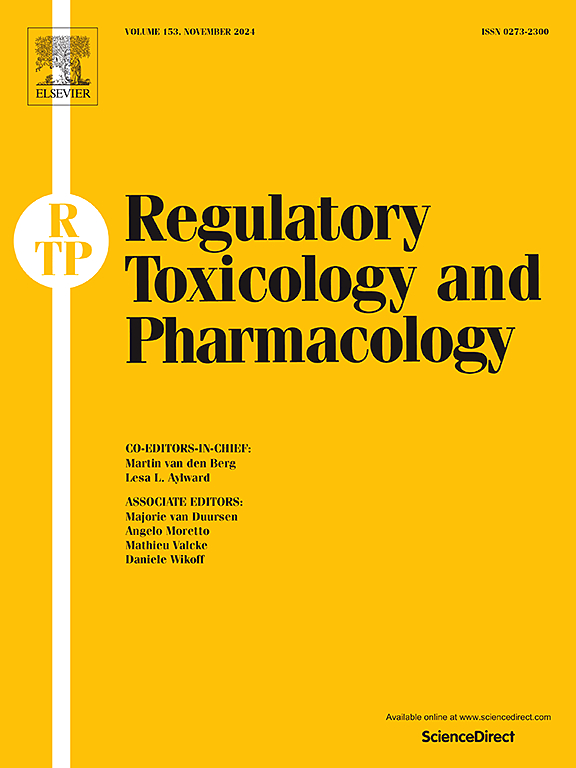No toxic effects or interactions between aflatoxin B1 and zearalenone in broiler chickens fed diets at China's regulatory limits
IF 3
4区 医学
Q1 MEDICINE, LEGAL
引用次数: 0
Abstract
Currently, several countries such as China have established regulatory limits for six major mycotoxins in animal feed. However, these limits are primarily designed for single mycotoxin exposure. Co-contamination with multiple mycotoxins is increasingly common, and simultaneous exposure may lead to additive toxic effects. This study aimed to investigate the effects of individual and combined contamination of aflatoxin B1 (AFB1) and zearalenone (ZEA) at China's regulatory limits on the growth performance, oxidative stress, serum biochemistry, immunity indicators, intestinal morphology, liver and kidney histopathology of broilers by incorporating mycotoxin standards into the feed. A total of 432 one-day-old male AA broilers were randomly assigned to four treatment groups, each consisting of six replicates of 18 birds. The control group received a basic diet, while the experimental groups were supplemented with 10 μg/kg AFB1, 500 μg/kg ZEA, or a combination of both in the basic diet. The experimental period lasted for 35 days. The results revealed no significant differences among the groups in terms of growth performance, oxidative damage markers, serum biochemistry, cytokine levels, intestinal health, or histopathological assessments of the liver and kidneys. Furthermore, no toxic interactions between the two mycotoxins were observed. Taken together, these results suggest that future assessments should take into account the combined toxicological effects of a wider range of mycotoxins to inform the revision and formulation of feed safety standards.
黄曲霉毒素B1与玉米赤霉烯酮在中国标准饲粮中的毒性效应及相互作用
目前,中国等几个国家已经对动物饲料中的六种主要真菌毒素制定了监管限制。然而,这些限值主要是针对单一霉菌毒素暴露而设计的。与多种真菌毒素的共同污染越来越普遍,同时接触可能导致累加性毒性作用。本试验旨在通过将霉菌毒素标准掺入饲料中,研究黄曲霉毒素B1 (AFB1)和玉米赤霉烯酮(ZEA)单独污染和联合污染对肉鸡生长性能、氧化应激、血清生化、免疫指标、肠道形态、肝脏和肾脏组织病理学的影响。选取432只1日龄雄性AA肉鸡,随机分为4个处理组,每组6个重复,每组18只鸡。对照组饲喂基础饲粮,试验组在基础饲粮中分别添加10 μg/kg AFB1、500 μg/kg ZEA或两者同时添加。试验期35 d。结果显示,在生长性能、氧化损伤标志物、血清生物化学、细胞因子水平、肠道健康或肝脏和肾脏的组织病理学评估方面,各组之间没有显著差异。此外,没有观察到两种真菌毒素之间的毒性相互作用。综上所述,这些结果表明,未来的评估应考虑到更广泛的真菌毒素的综合毒理学效应,以便为修订和制定饲料安全标准提供信息。
本文章由计算机程序翻译,如有差异,请以英文原文为准。
求助全文
约1分钟内获得全文
求助全文
来源期刊
CiteScore
6.70
自引率
8.80%
发文量
147
审稿时长
58 days
期刊介绍:
Regulatory Toxicology and Pharmacology publishes peer reviewed articles that involve the generation, evaluation, and interpretation of experimental animal and human data that are of direct importance and relevance for regulatory authorities with respect to toxicological and pharmacological regulations in society. All peer-reviewed articles that are published should be devoted to improve the protection of human health and environment. Reviews and discussions are welcomed that address legal and/or regulatory decisions with respect to risk assessment and management of toxicological and pharmacological compounds on a scientific basis. It addresses an international readership of scientists, risk assessors and managers, and other professionals active in the field of human and environmental health.
Types of peer-reviewed articles published:
-Original research articles of relevance for regulatory aspects covering aspects including, but not limited to:
1.Factors influencing human sensitivity
2.Exposure science related to risk assessment
3.Alternative toxicological test methods
4.Frameworks for evaluation and integration of data in regulatory evaluations
5.Harmonization across regulatory agencies
6.Read-across methods and evaluations
-Contemporary Reviews on policy related Research issues
-Letters to the Editor
-Guest Editorials (by Invitation)

 求助内容:
求助内容: 应助结果提醒方式:
应助结果提醒方式:


